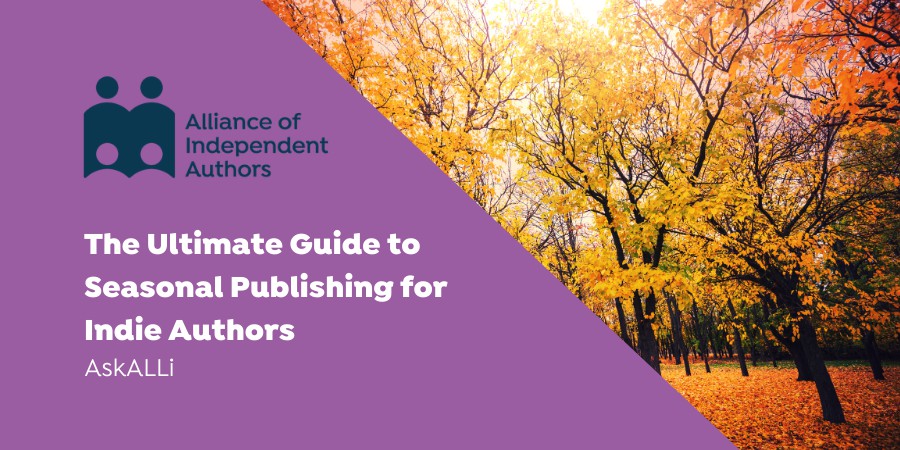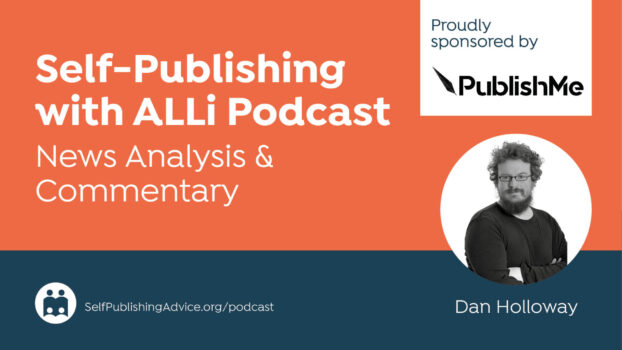Traditional publishing is organized around seasons, which you’ll have seen in the bestseller charts and the marketing activities of bookstores. Should indie authors also follow these seasons? Are there any aspects we could do in a different way, as our business model is more nimble? That's the topic the Alliance of Independent Authors AskALLi team is tackling today. This is the ultimate guide to seasonal publishing for indie authors.
In trade publishing, a book is assigned to a season: Christmas, spring or fall. The in-house sales team considers all the books for a season and selects some for bigger budgets and preferential positioning. The sales reps take that season’s catalog to the bookstores. Of course, trade publishing revolves around print runs, which compete for shelf time. Most of the books are destined to be sent back, when they don’t sell during the time allocated to them in that season.
By contrast, digital publishing – e-book and print on demand – seems seasonless and according to US Publishers’ Weekly, “digital catalogues, the 24/7 news cycle, and new rep roles threaten to make traditional publishing seasons outdated”.
Indie authors are much more nimble and, by publishing direct to readers on online platforms, escape the constraints of these publishing seasons.
But seasonal publishing still has a meaning for indie authors, because certain books sell better than others at certain times of the year.
Seasonal Reading
We asked ALLi members how the seasons affect their reading habits.
Historical fiction author Ayşe Osmanoğlu says:
“I read far more in the summer, particularly when I’m on holiday and lazing by a pool.”
Cozy mystery author Debbie Young says:
“I read a lot all year round, and am more likely to read books in season (or at least I am unlikely to read Christmassy books midsummer), although I don't seek them out according to what season we’re in.”
Travel and lifestyle author Lorraine Turnbull says:
“Reading tends to be autumnal and winter, in front of the woodburner or in bed.”
Memoirist and fantasy author Jean Gill says:
“I'd never read a book with ‘Christmas' in the title except during the Christmas period. My favourite winter reads are big fantasy adventures with treks across snow.”
Seasonal Patterns
These are common patterns. Fireside reads in autumn, beach reads in summer and special editions for Christmas. For northern hemisphere authors, June to August are the months for summer beach reads. In the southern hemisphere, your readers are on the beach from December through February. What counts as a beach book? Typically, it’s thrillers and “lighter” reads.
December in both hemispheres brings a frenzy of cozy Christmas titles, romance novels themed on Christmas, and kids’ stories involving Santa, reindeer and elves.
And it’s worth thinking beyond those who celebrate Christmas. There are many seasons and holidays across the globe that can provide opportunities for you to publish – Ramadan, Diwali, Hanukkah, Chinese New Year, Easter, Summer and Winter Solstice, Beltane, Samhain, Yule, Eid, Rosh Hashanah, Holi.
Options Throughout the Year
There are also opportunities in the typical rhythms of life. January is well known for New Year’s resolutions, a time when people pick up or restart hobbies, look for fitness or other health-related activities or try to accomplish something new. This is a boom time for non-fiction books, especially niche hobbies or self-help topics. If those are your areas, try to publish in January or ensure your books are out by January.
February often brings a boost to romance authors, with Valentine’s day. But consider a Valentine’s push if you’re a poet publishing love-themed books or a nonfiction author specialising in relationships.
October is a good time for horror books and anthologies, to capitalise on Halloween.
Also, consider national days. These are available for all kinds of niche topics – Science Fiction Day, Introvert Day, Mental Health awareness, International Women’s Day, World Book Day, Black History Month. If Pride month is applicable for your work, you’re in luck – there are several throughout the world, according to your country. If appropriate, you could team up with local businesses or national organisations to boost each other’s activities.
And you don’t have to limit yourself to established celebrations. Debbie Young makes strategic use of each month: “I purposely set my books in different seasons as I have two series (one complete, one part done) which run the course of a calendar year, and differentiating between the seasons adds interest and colour and atmosphere. It also means I have one in each series that is topical to promote at any particular time of year.”
Seasonal Creative Energy Flow
So that’s the seasonal peaks to consider for your publishing. What about your own creative seasons?
Many ALLi members who are parents find they predominantly write during term times when their children are at school.
Ayşe Osmanoğlu says:
“I can only write in term time. Having five children makes it impossible to find any quiet writing time during the school and university holidays. I also find it far easier to write when the weather is dull and grey, so I definitely write less during the summer.”
Debbie Young has a similar routine:
“While my daughter has been at school, I've written more in term-time when I have more time to myself at home during the day, and I've tended to take the school holidays off to be with her and to let my creative batteries recharge. However, as she has just left school and begun a pre-university gap year, I'm going to have to recalibrate my schedule to make sure I get plenty of writing done without missing out on quality time with her before she flies the nest.”
But school term times aren’t the only time our creative energy fluctuates. Some writers like to hibernate more in winter, and report that being indoors gives them the opportunity to write. For others, being indoors is a time for rest and recuperation. They find the words come more easily in the summer when their energy is higher.
Crafts book author Angie Scarr says: “I write more in the summer. When I'm a bit sleepless my mind switches to creative mode pretty easily and I get a lot of sleepless nights in summer so I write a lot in the early hours of the morning. It’s not always good work but there are flashes of inspiration worth collecting. One day those ramblings will be published.”
Chick-lit and fantasy novelist Kristina Adams says: “I write more in the winter because I hide indoors and there's something about the heat that makes me less productive. It's not something I planned, just a pattern I've noticed. It works well, though, because my genre is most popular in the spring and summer. It will be interesting to see how this changes as I change genres.”
Seasonal Marketing Considerations
Following seasonal trends can bring headaches for marketing. Typically, the price of cost per click adverts increases because everyone, including traditional publishers, is trying to push their books. But there are plenty of other things we can do to boost sales and readership.
Preparation
Can you do a review drive before your intensive sale period to improve the amount of social proof you have? When was the last time you asked your readers and on social media for reviews?
If you want to book newsletter ad spots like Bookbub, have you applied? Some newsletters require booking up to three months in advance.
Have you considered bundling some of your books into a set to sell? If so, what work would you need to do? Obviously, you’d need to format the books into a boxset.
What about working with a group of authors to create an anthology of existing or new work, based on a theme for an upcoming season? If so, how long do you need to write, revise, have it professionally edited and designed to ensure you hit the perfect launch date?
Consider promotion. Have you researched relevant hashtags? Have you bought seasonal imagery for use in adverts?
Think local. Are there local events or businesses who will be running seasonal events that coincide with your promotion or something connected to your book? Could you reach out and connect with them to work together?
Could you run live digital events to promote your book where you take questions or play seasonal games with your audience?
Also, why not instal a shop on your website?
Make good use of scheduling services. Schedule up your social media images. Write your mailing list emails in advance. Then, on the busy days, you’re free to interact with your audience as they comment and reply. And if you’re running a discount, don’t forget to schedule it in advance on the stores that allow this and discount it in time on the stores that don’t.





What a fascinating piece. I’ve been thinking a lot about seasonal creativity – I get loads of ideas in the Spring and then have to decide which ones to grow; then hopefully bring them to ‘harvest’ with that back-to-school energy in the Autumn. Does anyone else feel their creativity ebbs and flows with the seasons?